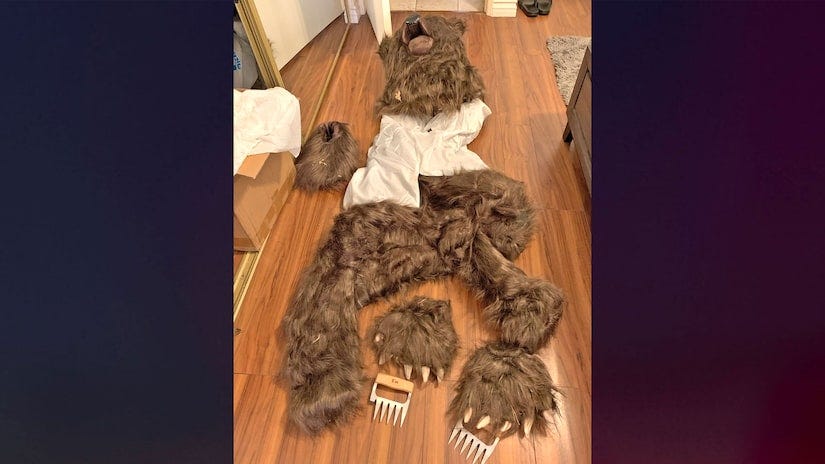Financial crime of the week #1: The bear who broke into a Rolls-Royce
Each week of this fincrime series, I’ll be going over a unique financial crime of some sort to explore the story - in Operation Bear Claw, a wayward bear commits insurance fraud in luxury vehicles
I grew up in a suburb of Los Angeles where one of the most common scams teenagers ran against their Armenian parents involved saying they were going to Lake Arrowhead or Palm Springs for a weekend trip when in fact it was a group trip to Vegas.
In retrospect I suspect everyone had to either be in on it or truly be that dumb, but the scam worked enough times that it kept happening. There are lots of reasons for this deception (I maintain that my community really needs to get into surveillance technology as far as I’m concerned).
In other words, there’s a fine line between truths we accept and are willing to entertain even when it begins to scratch the surface of being a blatant lie - much like teens claiming to be going to the mountains when instead they’re piling on mountains of cheap vodka in Caesar’s Palace - and that’s a fair way to also describe insurance systems as they handle claims, which forms the basis of this post. This whole tension between the truth and stretching it is also why the inaugural Financial Crime of the Week post for my website is accordingly an homage to my roots and the absurdism of such a cultural pathos taken to its stereotypical end.
Crime requires creativity, and today’s topic - Operation Bear Claw - involves a cohort of luxury vehicles, wildlife biologists, misused kitchen instruments, and a large furry costume of the non-sexual kind.
While it does not involve any delicious pastries of the same name, and beyond the unkinky use of a bear costume in this insurance fraud scheme, this crime is also a cautionary tale about details and why they matter as you’ll see when you read on (such as the number of claws bears have versus the number of prongs on meat claws sold at Williams Sonoma.)
Now, let’s start from the beginning - I mentioned I grew up in LA, and Lake Arrowhead, if you’re unfamiliar, is a small mountain resort town in the San Bernardino Mountains about 90 miles from LA. People often vacation there for weekend trips for reasons unknown to me as I have zero tolerance for bugs, water, or skiing (best I can give you is a hike). Given the region, black bears are often known as a nuisance in the Lake Arrowhead area as they regularly break into cars looking for food (in this economy, who can blame them), but since this happens enough, area locals know not to leave anything edible in their vehicles. Bears in the area are a known problem, and just as known is their dexterity in having learned to open car doors.
On January 28, 2024, one particularly enterprising bear broke into three luxury vehicles parked in Lake Arrowhead. It appears this bear is a fan of gaudy status-signaling, as it happened to break into one 2010 Rolls-Royce Ghost, one 2015 Mercedes G63 AMG, and one 2022 Mercedes E350 for a total claimed amount of damage between the three cars in the amount of $141,839 (which averages out to about 47k per car). Indeed, four people from the Glendale area filed insurance claims for bear damage to their three vehicles on the same day. Now, nothing about the story’s elements per se seemed immediately suspicious. On paper, sure, bears are in the area, the setting made sense, the narrative was plausible enough (though why would you leave the doors open to a hundred and twenty thousand dollar car), but the medium carries the message just as much. Enter the void or rather the video footage of the bear attacks on the luxury vehicles, which is where it got messy…and dear reader, you can view it yourself here too (sourced via AP news)
The video footage of this enterprising bear showed the bear approaching the cars, opening the doors, getting inside, and…pawing at the leather interior. That’s right: apparently a brown bear got into a Rolls-Royce presumably in search of food but instead decided to claw at the interior leather to absolutely destroy it. This enterprising bear almost got away with it, if it hadn’t been for those meddling bear claw skid marks being the incorrect number of claws to begin with.
The crazier part? The four defendants of this crime all filed their claims about the bear break in on the same day. For three different luxury vehicles. With three different insurance companies. One could say they certainly laid their cards bare (sorry, I couldn’t help myself). They almost pulled it off, but if only they had been a little more attentive and cared about patterns.
Something about this coincidence (to say the least) triggered a deeper look by the insurance companies involved who then handed it off to the state investigators. Here’s where it gets interesting - the plot twist is that the scheme worked right up until someone at the California Department of Insurance actually paid attention to the pattern in the video for the supposed bear clawing. When investigators pulled the videos, the problems became obvious. The “bear” was grabbing door handles in ways that didn’t match how bear paws actually work. The gait was wrong. The body positioning inside the vehicles was wrong. This thing moved like a person crouching and reaching around, not like wildlife investigating an enclosed space looking for snacks. So they called in an actual wildlife expert from the state - it turns out the California Department of Fish and Wildlife employs biologists who spend their entire careers studying bear behavior. These are people who can tell you the biomechanics of how a bear opens a cooler versus how a human in a bear suit opens a cooler. Today I learned all of these were even a thing, but more pressingly, here’s where attention to detail becomes critical (remember when I said that matters?). Real bears leave irregular scratch patterns. Different depths, varied spacing, uneven pressure because bears aren’t precisely dragging their claws across surfaces with systematic intent. They’re just, you know, being bears.
Dear reader, bears have five toes. The claw marks reflected six toes.
I need to emphasize this because it’s important. Someone had gone to a kitchen supply store, purchased meat claws (the kind with six metal prongs designed for shredding pulled pork), squeezed into a bear costume, and decided the best path to $141,839 was filming themselves trashing luxury vehicles. Bears are chaotic and their claw marks should reflect this instead of perfectly matched scratches from a food shredding device.
When investigators executed their search warrants in November 2024, they recovered the pictured bear costume and meat claws. Six metal prongs. Perfect match to the scratch patterns on the vehicle seats.
All four defendants were arrested and charged for insurance fraud and conspiracy.
In my view, the meat claws are what make this case legendary. They aren’t specialized fraud equipment, nor special. They are literal barbecue accessories you can buy on Amazon for $15 with Prime shipping. In fact, Williams-Sonoma has one on sale for $7.99 right now (I’m not a shill, I swear. Though looking at that website while writing this makes me want a steak. Stay away from the grilling accessories subpage.)
Someone looked at those six metal prongs and thought “close enough to bear claws” and just fully committed to the bit. That’s the kind of confidence that either succeeds spectacularly or fails completely. Details! Details! The devil is in the details because one more thing - the bear costume choice reveals another detail problem. Scroll up to look at it again - it’s a light brown bear costume, right? California only has black bears. Brown bears went extinct in California in the 1920s. We no longer have cuddly soft grizzly bears even though it’s on the state flag! So this is like filming footage of a penguin waddling around the Mojave Desert and claiming it is native fauna. I was always the picky person for group projects in school but I was right more often than I was wrong, goddamnit - details matter!
Anyways, to this cohort where details amongst other things did not seem to matter, if convicted, each defendant faces years in federal prison for what amounts to a YouTube quality costume and kitchen supplies from Amazon.
The gap between “this might actually work” and “this will definitely not work” turned out to be basic biology and one professional who knew how to count bear toes.
Welcome to Financial Crime of the Week. We’re just getting started.




